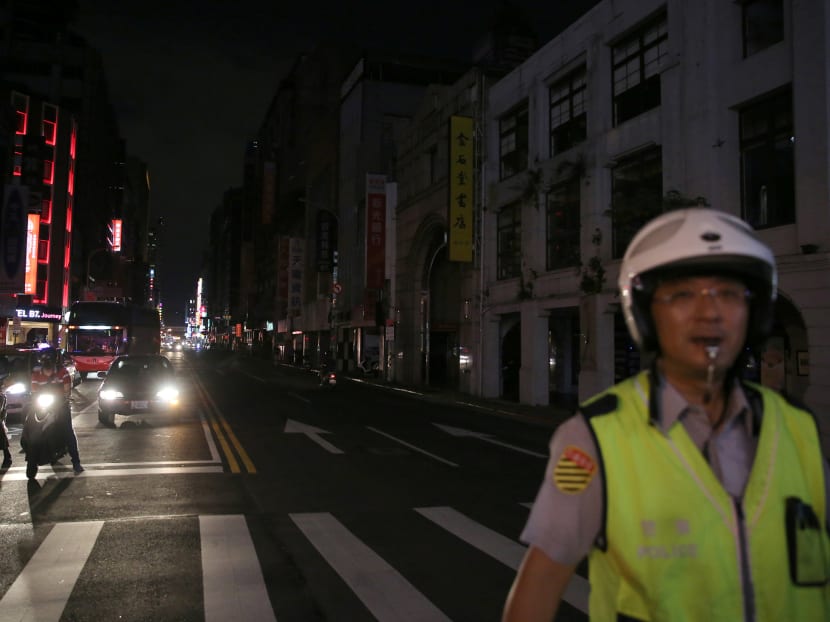Doubts cast over Taiwan’s plans for nuclear-free future following blackout
TAIPEI — Taiwan suffered its worst ever power outage last week, with close to seven million households in 17 cities and counties being left in the dark for up to five hours.

A police officer on duty in Taipei during the massive power outage that hit Taiwan on Aug 15, 2017. Photo: Reuters
TAIPEI — Taiwan suffered its worst ever power outage last week, with close to seven million households in 17 cities and counties being left in the dark for up to five hours.
The Aug 15 incident has not only shown how vulnerable the government’s current energy policies are, but also prompted public questioning of the idealistic, nuclear-free future promised by President Tsai Ing-wen, as well as her ability to run the island.
The incident took place when an operational error by government-owned CPC Corporation caused power generation at the gas-fuelled Datan plant in Taoyuan to be temporarily interrupted. The result was a total shortfall of 4.65 million kilowatts all over the island.
The authorities were inundated by criticism with Economic Affairs Minister Lee Chih-kung and CPC chairman Chen Chin-te both resigning.
Ms Tsai also apologised to the public, promising to review the situation and act to ensure a steady supply of power in the future.
According to initial findings, the failure to follow standard operating procedures by CPC and its contractor created a gas feeding problem, which caused six units of the Datan plant to shut down automatically for safety reasons.
The reduced voltage also affected the operations of the generator at another power plant in Taichung.
The shutdown was reminiscent of the 2003 blackout in parts of north-eastern and mid-western United States and the Canadian province of Ontario. A review found that a programming error had led to the automatic shutdown of 508 generating units at 265 power plants.
The resignations of the two Taiwanese officials and Ms Tsai’s apology, however, have failed to address public concerns over whether the government is able to keep its promise that there would be no power shortages as result of the government’s plans to scrap nuclear power.
Ms Tsai has promised a nuclear-free Taiwan by 2025 – using green or renewable energy like wind, solar and water, as well as gas and coal – to replace the energy now generated by the island’s three nuclear power plants.
She has also promised not to start using a fourth nuclear plant. The construction of the Lungmen plant has resulted in countless protests by environmentalists and residents living near the site.
But the Aug 15 blackout has served only to fuel speculation over the promise of a nuclear-free Taiwan. Given that a man-made error like that of Aug 15 can paralyse much of the island, the public – especially business leaders – have started to question whether the government is capable of maintaining a constant supply of power.
Mr Hsu Sheng-hsiung, head of the Taipei-based Chinese National Federation of Industries and who was trapped in a lift during the blackout, said he was sorry to find that Taiwan, once the head of Asia’s “four dragons” was now facing power supply problems that would only reduce the island’s competitiveness.
Another business leader, Mr Lin Bo-feng, who is the chairman of the Taipei-based Chinese National Association of Industry and Commerce, called for reinstatement of the controversial fourth nuclear power plant.
With temperatures hitting record levels this summer, power consumption in Taiwan is expected to increase, which raises the risk of repeated blackouts.
According to figures from the government-run Taiwan Power Company, total power consumption during the afternoon of Aug 15 rose to 3.6 million kilowatts – just short of the maximum 3.7 million kilowatts available at the time.
With the development of green energy still falling far short of the government’s target, it would be a wishful thinking for the government to continue to rely on the use of the green energy to replace nuclear power by 2025.
Taiwan’s Premier Lin Chuan has recently set a goal of generating a further 3.5 million kilowatts from wind energy over the next eight years, but experts warn that the target will not be easy to reach given protests from residents living near wind farms and concerns about the environmental impact of building turbines.
While it appears impossible for the government to reconsider its nuclear power policy, it might be wiser for it to extend the deadline for closing all the island’s nuclear plants if Ms Tsai is to retain the support of the public.
The latest opinion survey by a pro-government foundation showed that the approval rating for the president has slipped more than 40 points to 29.8 per cent in the past year. SOUTH CHINA MORNING POST






